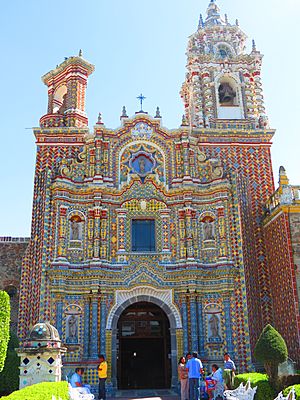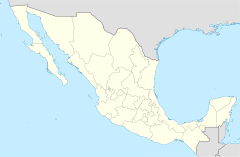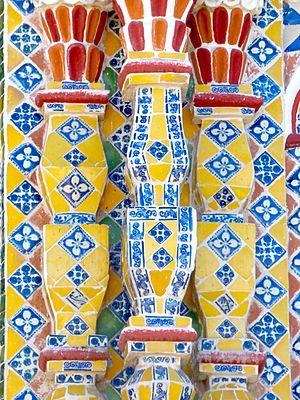Church of San Francisco Acatepec facts for kids
Quick facts for kids Church of San Francisco Acatepec |
|
|---|---|

The church's exterior in 2013
|
|
| Location | |
The Church of San Francisco Acatepec is an old church from the time when Spain ruled Mexico. It is famous for its unique style, called Mexican Baroque. What makes it special is its front, which is covered in colorful Talavera tiles mixed with red bricks.
You can find this church in the town of San Francisco Acatepec, which is in San Andrés Cholula, near the city of Puebla in Mexico. It was one of the first churches built in this area.
Building the church started in the mid-1500s and finished in 1760. The beautiful tiles on the front of the church were made between 1650 and 1750. These tiles are a type of azulejo, which are glazed ceramic tiles.
Contents
History of the Church
Plans for building this church began in the 1500s. At that time, a group of monks called the Franciscans set up a small monastery there. Around 1560, the Franciscans started building a church on the same spot. However, the church you see today was mostly built later, during the late 1600s and 1700s.
Many churches in the Puebla region, built in the 1600s and 1700s, are known for their colorful tile fronts and red bricks. The ceramic tiles on this church were handmade between 1650 and 1750. This was when Talavera pottery from Puebla became a popular way to decorate Baroque buildings in the area.
In 1946, a famous movie director named Emilio Fernández chose the Church of San Francisco Acatepec as a filming location. It was used for his movie Enamorada, which starred well-known actors María Félix and Pedro Armendáriz.
What the Church Looks Like
The Atrium Entrance
The church has a large open area in front of it called an atrium. It's similar to other Franciscan church atriums, but a bit smaller. This area has eight sides and three ways to enter. The main entrance has a special arch shape called a mixtilinear arch, which was built in the 1600s.
The atrium was built even before the current church. It wasn't just for looks. It also served as an capilla abierta (an open chapel) and a sacred cemetery for the people. People were buried there during the 1600s and 1700s. You can still see some old tombs there today, with the oldest one dating back to 1887.
Church Layout
The church is shaped like a Latin cross when viewed from above. It has seven main sections. The first section holds the choir and the area below it. The sixth section is the transept, which is the part that crosses the main body of the church. The seventh section is the chancel, where the altar is.
The sacristy, a room where priests prepare, is on the south side of the transept. It's a rectangular room with two parts. The ceiling of the church is a barrel vault with curved openings called lunettes. The dome is shaped like a half-circle and sits on an eight-sided base.
The Beautiful Facade
The front of the church, called the facade, was built in the late 1700s. It features special columns called estipite columns. What really stands out is its colorful Baroque style, covered in Talavera azulejos. These tiles were made just for this church.
The colors of the pottery have special meanings. The white and blue represent the Virgin Mary, while the green and yellow represent Saint Joseph. The facade has two main levels and a decorative top with spiral shapes called volutes. It also has torch-shaped decorations called pinnacles on both the bell-gable (the part holding the bells) and the tower. These decorations look like fancy pastries.
Manuel Toussaint, an art historian, once said it looks like a "porcelain church." The facade has small, flat columns called pilasters, completely covered in tiles. The church's only tower also has twisted columns called salomonic columns, all covered in tiles. One writer, José Moreno Villa, said that the tile work is so amazing it's "like a great ceramic toy."
The Tower
Manuel Toussaint also noted that the church's main tower is covered in a type of glazed pottery called maiolica. Like the facade, it follows the Baroque style and has very detailed decorations. The church also has an extra bell tower on the right side, decorated with red bricks and colorful tiles.
Inside the Church
The inside of the church is richly decorated with golden designs and colorful figures. The special stones at the top of the arches, called keystones, and the supports that stick out from the walls, called corbels, are particularly interesting.
The interior, like the front, has many Baroque elements. There's a golden altarpiece (a decorated screen behind the altar) at the main altar. Some parts of the interior remind people of the Chapel del Rosario in Puebla, but with a more local, popular style. Unlike the Church of Santa María Tonantzintla, this church's interior doesn't show as many images from local indigenous cultures.
The golden decorations are a key feature inside. In the choir area, there are many colorful designs. One observer, Ciancas, mentioned the "simple and popular touch given by countless figures of little angels" on the twisted columns of the altars. These were restored after a fire inside the church.

A notable feature is the plaster work showing the Incarnation (when God became human) and the Birth of Jesus. It includes symbols of the Holy Trinity and a bright sun. In the main ceiling vault, you can see the Holy Family. Other plaster figures inside include angels, cherubs, and child-like figures. There are also three golden altarpieces on the walls, including the main altar.
The saints on the altarpiece are carved from wood and painted with a special technique called estofado, which makes them look like they have rich fabrics. The pulpit, where sermons are given, also stands out with its unique shape and colorful decorations.
On the side arches, you can see scenes from the Gospels. These show symbols of the four evangelists: Saint Matthew with an angel, Saint Mark with a lion, Saint Luke with a bull, and Saint John with an eagle. The church's stained glass windows show Saint Francis of Assisi, who is the main saint the church is named after.
Images for kids
See also
 In Spanish: Templo de San Francisco Acatepec para niños
In Spanish: Templo de San Francisco Acatepec para niños



















